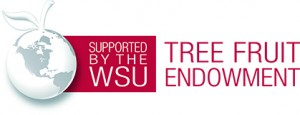Written by Achour Amiri, Washington State University, July 2, 2025
A Non-Recirculating Drencher to Reduce Cross-Contaminations and Postharvest Losses in Pome fruit
For decades, postharvest diseases have been managed using fungicide drenches at packinghouses. Traditionally, harvested fruit is driven into a drencher where fungicide solution is sprayed and recirculated for use on multiple loads. While effective, this practice poses a serious risk of cross-contamination as organic matter and microorganisms, including plant and foodborne pathogens, accumulate in the reused solution. While thermal fogging of fungicides is clean technology, it may result in an uneven fungicide distribution of the fungicide inside the storage room and may lead to elevated fungicide residues.
To address this, researchers at Washington State University evaluated a new non-recycling drencher (NRD) system (Figure 1), which offers a cleaner, more hygienic method of fungicide application without compromising disease control.

What Is a Non-Recycling Drencher?
The non-recycling drencher (NRD) is a portable system designed to apply a fresh fungicide solution to each batch of fruit, eliminating the reuse of contaminated liquid. This system helps prevent the spread of both plant pathogens and foodborne pathogens.
Key Features:
- A 1,400-gallons mixing tank connected to a spray bar with three nozzles
- Capable of treating four unstacked bins on a trailer in 12 seconds
- Delivers approximately 2 gallons of solution per bin
- Runoff drains onto a metal platform and is discarded
- Bins rest for 30 seconds to drain before the next cycle
How Effective Is It?
The non-recycling drencher (NRD) was compared to traditional commercial recirculating drenchers (CRD) using both fludioxonil + thiabendazole (2021) and pyrimethanil (2022) as treatment fungicides. We measured spray coverage, fungicide residue levels, and disease control.
Key Findings:
- Equal or spray coverage with NRD compared to recycling commercial drencher (CRD).
- Comparable or lower levels of postharvest disease, including reduced blue mold incidence (Table 1).
- Significantly reduced contamination by Penicillium (blue mold) and Mucor sp. (Mucor rot) in both the fungicide solutions and on apple surfaces
Table 1. CRD and NRD refer to commercial recirculating drencher and non- recirculating drencher, respectively. Values in the same column followed by different letters are statistically different.
| Overall disease incidence and incidence of major diseases | |||||||||
|---|---|---|---|---|---|---|---|---|---|
| Cultivar | Lot # | Method | Overall | Blue mold | Gray mold | Alternaria rot | Speck rot | Bull’s eye rot | Mucor rot |
| Honeycrisp | Hc902 | CRD | 1.8 b | 53.3 b | 36.2 b | 1.3 c | 2.6 b | 6.6 b | 0.0 e |
| NRD | 1.6 b | 37.5 c | 46.9 ab | 6.3 a | 4.7 b | 4.7 bc | 0.0 e | ||
| Hc1139 | CRD | 3.3 b | 64.7 a | 17.9 c | 2.9 bc | 5.4 ab | 2.9 c | 5.0 c | |
| NRD | 3.2 b | 43.7 b | 13.8 c | 1.6 bc | 0.9 ab | 2.8 a | 5.7 a | ||
| HC1156 | CRD | 2.5 b | 55.1 b | 20.7 c | 1.8 bc | 1.8 b | 2.6 c | 17.1 a | |
| NRD | 2.5 b | 42.9 b | 38.3 b | 3.7 ab | 5.0 b | 5.0 b | 5.0 c | ||
| HC1918 | CRD | 15.0 a | 52.0 b | 9.8 d | 0.8 c | 2.4 b | 2.7 a | 21.5 a | |
| NRD | 7.1 ab | 36.3 c | 17.2 c | 2.1 b | 4.1 a | 9.3 a | 11 b | ||
| Gala | Ga901 | CRD | 0.2 e | 51.6 b | 12.9 c | 6.5 a | 3.2 b | 6.5 b | 19.4 a |
| NRD | 0.3 de | 35.7 c | 40.4 b | 4.8 a | 7.1 ab | 4.8 b | 7.1 bc | ||
| Ga1113 | CRD | 0.6 cd | 27.9 c | 36.0 b | 4.7 a | 3.5 b | 2.3 c | 25.6 a | |
| NRD | 0.9 c | 30.4 c | 58.2 a | 1.7 b | 2.6 b | 4.3 b | 2.6 d | ||
| GA1124 | CRD | 2.1 b | 63.3 a | 11.6 c | 1.6 b | 1.8 b | 2.8 c | 18.5 a | |
| NRD | 0.4 cd | 55.8 b | 15.1 c | 0.0 d | 4.7 b | 6.9 b | 12.8 b | ||
Conclusion
The non-recycling drencher represents a safer, effective alternative to traditional fungicide drenching methods. By using a fresh solution for each application, it maintains robust control of postharvest diseases in apples and pears while minimizing the risk of cross-contamination. This innovative approach aligns with industry goals of improving food safety, fruit quality, and sustainable handling practices.
Contact
Achour Amiri
Washington State University
a.amiri@wsu.edu
509-393-4058
Funding and acknowledgements
This work was supported by a grant from the Washington Tree Fruit Research Commission (WTFRC) Grant no. AP-21-101.
Reference
Amiri, A., Murphy, C. M., Hoheisel, G. A., Haskell, C. L., & Critzer, F. (2024). Efficiency of a non-recycling postharvest fungicide drencher to enhance management of apple decay and food safety. Frontiers in Microbiology, 15, 1509368.
Fruit Matters articles may only be republished with prior author permission © Washington State University. Reprint articles with permission must include: Originally published by Washington State Tree Fruit Extension Fruit Matters at treefruit.wsu.edu and a link to the original article.

